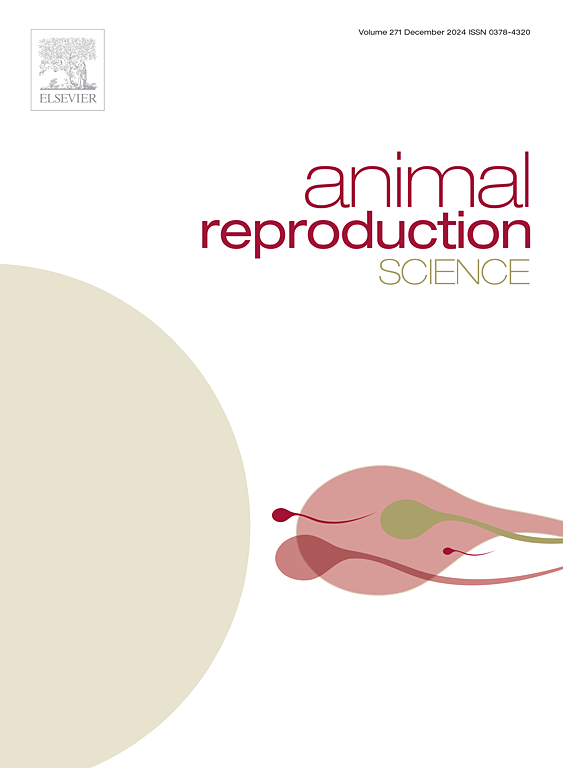GnRH给药对妊娠率和产仔数的影响,母羊在繁殖季节接受固定时间的授精程序。
IF 3.3
2区 农林科学
Q1 AGRICULTURE, DAIRY & ANIMAL SCIENCE
引用次数: 0
摘要
本研究的目的是比较GnRH在海绵植入、授精和授精后第7天对母羊妊娠率和产仔数的影响,母羊在繁殖季节接受固定时间授精。在四个试验点对2740只母羊进行了发情同步。将经醋酸氟孕酮浸渍的阴道内海绵留在阴道内12天,然后在海绵取出时注射330 IU eCG。每只母羊在去除海绵后分别于52 h和64 h进行两次授精。在插入组、授精组和授精后组,母羊分别在海绵插入、授精和授精后第7天肌肉注射GnRH激动剂triptorelin 25 μg。对照组未给予GnRH治疗。在所有分娩完成后计算怀孕率和产仔数。结果显示,插入组的妊娠率明显高于对照组、人工授精组和人工授精后组。插入组和授精组产仔数差异不显著,显著高于对照组和授精后组。综上所述,固定时间人工授精,结合海绵植入时给药GnRH,是一种在繁殖季节提高发情同步母羊生育力的简单而有效的策略。本文章由计算机程序翻译,如有差异,请以英文原文为准。
Effects of GnRH administration on pregnancy rate and litter size in ewes subjected to a fixed time insemination program during the breeding season
The objective of this study was to compare the effects of GnRH administration at sponge insertion, insemination, and day 7 post-insemination on pregnancy rate and litter size in ewes subjected to a fixed time insemination program during the breeding season. Estrus was synchronized in 2740 adult ewes at four experimental sites. An intravaginal sponge impregnated with flurogestone acetate was left in the vagina for 12 days followed by an injection of 330 IU of eCG at sponge removal. Each ewe was in seminated twice at 52 h and 64 h after sponge removal. In the Insertion group, the Insemination group, and the Post-insemination group, ewes were given an intramuscular administration of 25 μg of the GnRH agonist triptorelin at sponge insertion, insemination, and day 7 post-insemination, respectively. No GnRH administration was given in the Control group. Pregnancy rates and litter size were calculated after all deliveries were completed. The results showed that the pregnancy rates in the Insertion group were significantly higher compared to those in the Control group, the Insemination group, and the Post-insemination group. The litter size in the Insertion group and the Insemination group were not significantly different and were significantly higher compared to those in the Control group and the Post-insemination group. In conclusion, the fixed time artificial insemination program, in combination with GnRH administration at sponge insertion, is a simple and potentially effective strategy for increasing fertility in estrus-synchronized ewes during the breeding season.
求助全文
通过发布文献求助,成功后即可免费获取论文全文。
去求助
来源期刊

Animal Reproduction Science
农林科学-奶制品与动物科学
CiteScore
4.50
自引率
9.10%
发文量
136
审稿时长
54 days
期刊介绍:
Animal Reproduction Science publishes results from studies relating to reproduction and fertility in animals. This includes both fundamental research and applied studies, including management practices that increase our understanding of the biology and manipulation of reproduction. Manuscripts should go into depth in the mechanisms involved in the research reported, rather than a give a mere description of findings. The focus is on animals that are useful to humans including food- and fibre-producing; companion/recreational; captive; and endangered species including zoo animals, but excluding laboratory animals unless the results of the study provide new information that impacts the basic understanding of the biology or manipulation of reproduction.
The journal''s scope includes the study of reproductive physiology and endocrinology, reproductive cycles, natural and artificial control of reproduction, preservation and use of gametes and embryos, pregnancy and parturition, infertility and sterility, diagnostic and therapeutic techniques.
The Editorial Board of Animal Reproduction Science has decided not to publish papers in which there is an exclusive examination of the in vitro development of oocytes and embryos; however, there will be consideration of papers that include in vitro studies where the source of the oocytes and/or development of the embryos beyond the blastocyst stage is part of the experimental design.
 求助内容:
求助内容: 应助结果提醒方式:
应助结果提醒方式:


